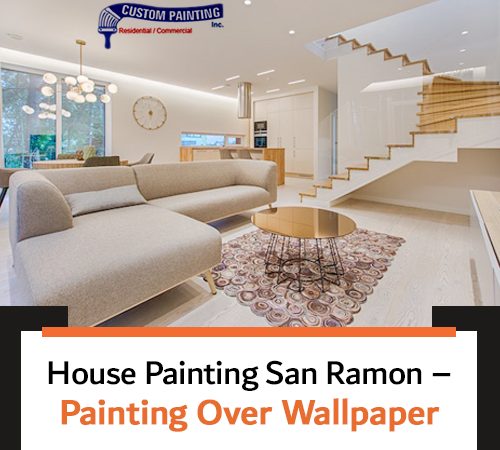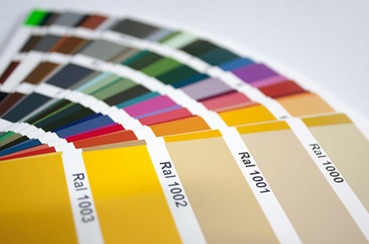
Do you want to get rid of your old wallpaper? House painting in San Ramon can be the solution you want without going through the time, effort, and often problem of removing the wallpaper.
You don’t necessarily have to remove your wallpaper to paint the walls. This is especially true if the wallpaper has been there for many years. Removing it may leave unexpected damage to your walls. But if the wallpaper is still in good condition or has an adhesive that’s impossible to remove by simply stripping it away, then painting over the wallpaper may be a valid option. Also, by leaving the wallpaper where it is and in its current condition, you can start to paint right away.
Do you want to change the look and feel of your home but are not keen on stripping off your old wallpaper? The alternative is to cover your wallpaper with a fresh coat of paint.
The advantages and disadvantages of painting over wallpaper
Can you really paint over wallpaper?
The answer: not only painting over wallpaper is doable, but many DIY home painters have usually preferred it over removing wallpaper.
But is it a good idea?
Of course, there will always be strong opinions on either side. One side always recommends removing your old wallpaper, even if it’s laborious and time-consuming. The other side insists that it’s outstanding to paint over old wallpaper, especially when it has been stuck so long that it is almost impossible to get it off your walls. It has become pretty much a part of your wall.
If you ask professional painters and industry experts whether or not it is okay to paint over wallpaper, chances are they will go against it and recommend wallpaper removal instead. But sometimes, removing wallpaper can damage the wall beneath it, something DIY home painters would not wish to happen.
The pros:
- It is a lot simpler and more accessible than removing wallpaper.
- It is more cost-effective.
- It is a DIY-friendly job.
- It saves you time, effort, and supplies.
- If your existing wallpaper is in generally good shape, it is possible to paint over it. It can even create an interesting look on the surface.
The cons:
- It is easy to mess up, especially if you don’t prep your walls first.
- If your existing wallpaper is in pretty bad shape, do more extensive prep work before painting over it, such as smoothing out air bubbles, fixing torn sections, or getting as much dust off the wallpaper as possible.
- The results may be far from satisfactory. The finish will likely be rough and messy.
- The paint finish may be rough and uneven due to the seams and frayed edges.
- If your wallpaper is textured, painting over it can be tricky. It is almost impossible to paint over it without the underlying patterns showing through the new topcoat.
How to paint over wallpaper
Despite the professional recommendation, many homeowners still find removing wallpaper daunting. They need to be more budget-conscious to invest in better tools or hire someone with experience in this department.
If you have decided to paint over wallpaper, you still need to do some correct prep work, as is with any painting job, to get a good finish. Follow the simple steps described below to arrive at the best results for painting over wallpaper.
Supplies needed:
- Trisodium phosphate (TSP) or substitute
- Bucket of warm water
- Wallpaper paste or glue
- Spackle or joint compound
- Putty knife
- Fine sandpaper
- Oil- or shellac-based sealer
- Oil- or shellac-based primer
- Painter’s tape
- Oil-based paint
- Mineral spirits
- Soft cloth
- Topcoat paint (the color is up to you).
Wear the following for protection:
- Goggles
- Gloves
- Mask or respirator
- Long-sleeved clothing
Steps to follow for the best results
- Clean the entire surface thoroughly with a soft, damp cloth. If the walls are greasy, use trisodium phosphate (TSP), an excellent cleaning agent. Alternatively, you can use something similar to TSP. There are TSP substitutes, most of which are sodium-carbonate-based. These TSP alternatives are eco-friendly but are less effective at removing oil or grime.
- After cleaning, rinse off the entire surface with water, and then use a clean cloth to remove traces of the cleaner. Let the walls dry completely before proceeding to the next step.
- Inspect the condition of the wall for any flaws before you begin to paint. If you don’t check your walls, you may notice more visible imperfections after the wallpaper has been painted. Feel the wallpaper with your hands to check for bumps, tears, and air bubbles. Check all the seams to see if there are peeling or loose pieces. If you find any peeling sections of the wallpaper, use wallpaper paste or glue to seal them.
- If you find any damaged areas and seams, cover them with spackle or joint compound using a thin putty knife. Please note that you may need to apply several coats of the joint compound because it begins to shrink once it dries. When you finish, you may still see some excess joint compound. Carefully sand it away.
- Use fine sandpaper to go over the walls to ensure a smoother surface. A sanded and smoothened surface will help the paint to adhere better.
- You may or may not need to apply a sealer over the wallpaper. But there are some advantages of applying a sealer. It will minimize the chances of the wallpaper peeling or loosening. Make sure you use an oil-based or shellac-based sealer. Never use a water-based sealer because this would cause the wallpaper to peel or loosen.
- Cover areas where you don’t want to paint or prevent paint from seeping. Use painter’s tape (blue tape) to cover areas such as baseboards or window trim – please don’t use any other tape. You will also want to remove the outlet and switch covers to keep from getting paint on them.
- Prime the surface. Just like a sealer, use an oil- or shellac-based primer. Don’t use water-based ones. When using a primer, it’s essential to read and follow the manufacturer’s instructions on the can. The primer will have the recommended application methods and drying time. After applying the primer, allow it to dry.
- After the primer has dried, check over the surface for possible flaws you might have missed. If you find any damage, apply spackle, and then coat the fixed surface again with a primer after the spackle has completely dried and been sanded.
- Now, it’s time to paint over the surface. Make sure to follow the manufacturer’s instructions. Use oil-based paints instead of latex (water-based). For best results, apply two coats of paint. Since oil-based paints take longer to dry (at least 24 hours or more), be patient to allow the first coat to dry completely before applying the second coat.
- Finally, gently and carefully remove the painter’s tape from the walls after the paint has dried.
Following the above steps for painting over wallpaper when house painting in San Ramon, you can change the look of the room to something that is fresh and what you want.

